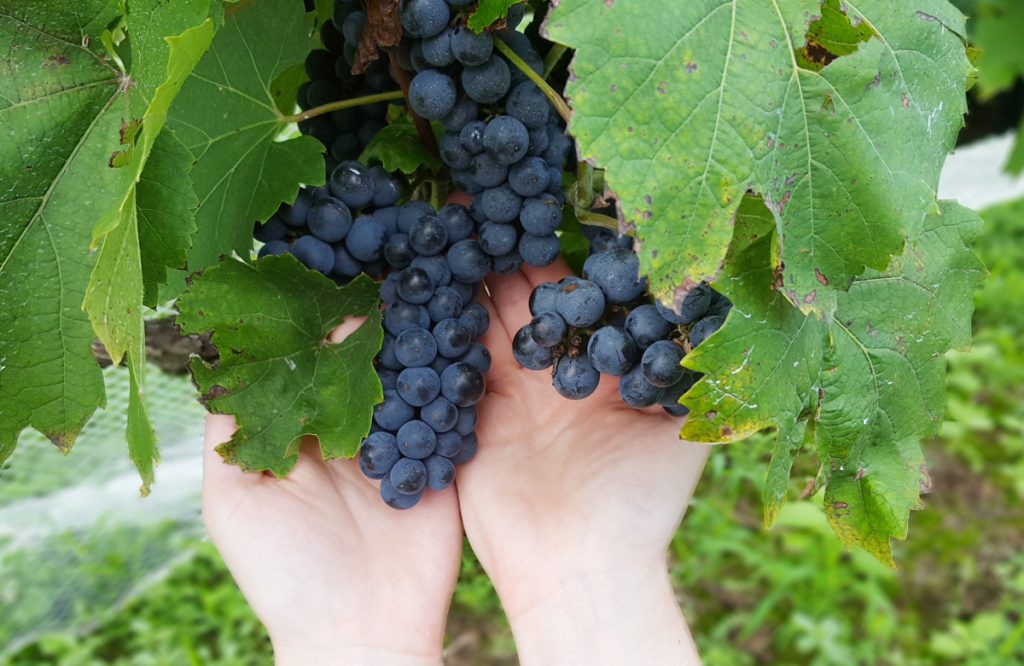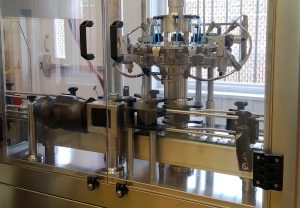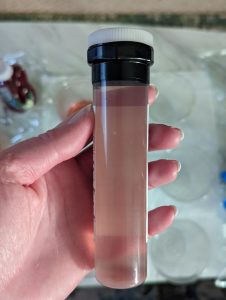
Photo by: Denise M. Gardner
It’s hard to believe another harvest season is sneaking up on us.
While there is probably TONS of work to be done in the vineyard, it’s also time to start preparing the winery for harvest. Do not let cellar preparation get away from you. Any good winemaking team will tell you that one of the key methods for reducing chaos and overwhelm in the cellar is to actually plan for the harvest season.
If you are a part of the DGW Community, you can access the Pre-Harvest Prep Production Guide, here. (If you aren’t a part of the DGW Community, do not despair! You can easily gain access to these tools for as low as $35/month – this is a steal for practical winemaking information and tools! Check out Membership options, here!) The Pre-Harvest Prep Production Guide is a complete list of all of the necessary things to consider before harvest begins so you don’t feel the stress of harvest during the actual season.
Otherwise, here are few freebie tips for easing into harvest and making the season more efficient for you and your team.
1. Finish Bottling
The key operation I try to encourage all of my winemaking clients to do before harvest begins is to complete bottling. Bottling is intense, requires attention to detail, and is often quite conflicting to harvest operations. If your harvest season begins in August, I challenge you to have your bottling completed by June so you can take a small break in July.

Photo by: Denise M. Gardner
With the rise of mobile bottling, it can be challenging for some winemakers to meet this deadline. However, as you start to plan for the following year (2026), make a calendar of processing operations to see if you can push more of your bottling into an earlier part of the year and avoid the harvest months next vintage.
Nonetheless, since both bottling operations and harvest operations can be compact with work, it’s best to get these two sets of operations separated. This will give your team more energy to get through each season and can greatly reduce the amount of fatigue associated with the harvest season. It’s also more hygienic. During bottling, it’s best to not have active fermentations going on in your cellar. Bottling during the active fermentation season can lead to increases in bottle contamination due to the higher prevalence of microorganisms in the cellar during the harvest season.
2. Get Your Cellar Supplies Early
I encourage all winemakers to get into the habit of reviewing and ordering all winemaking or enological supplies by June and July.
Every winemaker has a series of things they absolutely cannot go without during the harvest season. Thus, this planning step guarantees the necessities for harvest are considered and covered.
This is also a great time to review new products that may have hit the market since last harvest season. Setting aside a few hours before the grapes hit the cellar floor is a great opportunity to minimize some of the decision fatigue that creeps in during the harvest season. Through DG Winemaking, I publish a list of Harvest Must-Haves, which is a comprehensive list of enological items I think every winery should consider having in stock by the time harvest starts.

Photo by: Denise M. Gardner
Additionally, winemaking teams should make sure they have:
- Residual Sugar Testing Kits. While it may be challenging to find Clinitests nowadays, Presque Isle Wine Cellars has an alternative that can better assess when primary fermentation is complete. Other wineries may be prepared to use enzymatic assays for confirming the end of primary fermentation.
- Sample Tubes and Bottles for Analysis. This is a harvest must-have. Whether you plan on running your own analysis in-house or sending out samples, having a set of tubes and bottles to take adequate wine samples takes some of the inefficiency out of the harvest season. Some wine labs will send pre-printed labels or sample bottles if you inquire ahead of time. Consider checking the required sample volumes for certain analyses like pH, TA, and YAN. Want to really be on the ball? Stock up on ice packs and pre-printed analysis sheets or sample labels to identify the analysis you will most likely purchase during harvest. Being prepared saves time.
- Grape Biological Control Agents. Are your grapes going to sit in transport for some time before they reach the cellar door? You may want to consider checking out some biological control agents like the Lamothe-Abiet (L.A.) non-fermentative yeast product, Excellence B-Nature. These and other non-fermentative yeast products can aid in suppression of native microflora growth during these lag periods of time.
- Plan for Record Keeping. DGW Members and Clients now have access to spreadsheet templates Fermentation Records. This not only provides an easy-to-read spreadsheet for maintaining all of those numbers during the harvest season, but it provides all necessary analytical information required for a successful fermentation and, potentially, malolactic fermentation. Otherwise, winemakers are encouraged to develop their record keeping system now. Again, developing this necessary part of winemaking is inefficient during the harvest season.
3. Test Winemaking Equipment before Harvest Begins
In a recent vintage, I got called regularly about presses going down on the first or second days of harvest, and some of the presses were brand new. Unfortunately, this occurrence is more common than we may think and it is something that most wineries can prepare for the harvest season. Have a “backup plan” for if the press goes down during crush. Know who you can call or where you can gain access to a press if that situation arises. This may seem unnecessary, but freshly picked grapes or recently pressed juice require processing quicker than if the wine is fermenting or fermented. Quickly addressing a broken press is essential because the grapes/juice rapidly deteriorate.
It’s a good idea to pull out the harvest equipment a few weeks before harvest begins and run the equipment according to the manufacturer’s instructions. Completing any necessary repairs on equipment before grapes hit the crush pad is simply ideal.
It’s true that access to equipment and parts continues to be a struggle for many wineries. Bucher Vaslin has an inventory of spare parts available for their equipment. However, this may not be the case for all other equipment manufacturers. Now is a great time to familiarize yourself with your equipment and where to go for technical assistance in case of an emergency.
4. Review Winemaking Techniques for New Wine Styles
Certain wine styles like Pét-Nats, many sparkling wines, and even some styles of formula wines require the winemaker to take specific actions starting at harvest in order to optimize post-fermentation wine quality. By ignoring essential harvest steps, post-fermentation quality can get degraded or make the wines more challenging to finish. For example, getting a Pét-Nat in bottle that doesn’t gush everywhere when it’s opened may not be a possibility if the winemaker ignored specific harvest and fermentation processing operations.
Take the time to plan out processing steps and needs for new wine styles. DGW includes a few Production Guides, Articles, and Winemaking Lessons on some more specific wine styles:
- Pét-Nat Production
- Producing a Base Wine for Sparkling Wines
- Rosé Wine Style Variation and Production Details
- Co-Fermenting Red Wines
- Producing Appassimento Style Wines
- Altering Sulfur Dioxide Strategies for Juice and Wine
- Creative Wine Styles for Hybrid Wine Grape Varieties
If you are planning on trying something new this year and could use some assistance in avoiding those first-try mistakes, consider joining our DGW Elite Membership. This is a low-cost, consulting option that makes getting the help you need practical and affordable.
5. Secure Your Consultant BEFORE Harvest Begins
Maybe this is the year you are finally ready to adjust the wine’s quality to meet your expectations.
Most people come to me to get signed up for a consulting contract right as harvest begins. But this is not the right time to find a consultant. You want someone that can help you prepare adequately by the time grapes hit the crush pad.

Photo by: Savannah Smith Photography
Last year, I met with a winemaking team to discuss how they were making some of their white wines that they wanted to improve with some specific guidance in terms of what they were looking for from the wines. After I tasted those wines, we met to discuss processing details. From there, I made some alterations that I thought would better align with their desired taste outcomes. And guess what? It worked! A good winemaking consultant can help you do the same thing: focus on what you want from your wines and provide you with good guidance to obtain that goal.
If you think you want to find a winemaking consultant to help you through this upcoming harvest season, now is the critical time to find us. Not only does this ensure the consultant has time and availability to take you on as a client, but also a good winemaking consultant will begin to prepare your operation for harvest. This ensures that harvest goes more smoothly for you compared to previous years.
And again, if you aren’t in the market for a full-time consultant, but know you could use someone to help with all those winemaking questions around “what should I do,” then consider our DGW Elite Membership. In today’s world, there’s a lot of options available for improving your operations.
For more information on DGW Memberships and Consulting Packages…
Want the inside scoop on products and wine processes I recommend? Consider becoming a DGW Elite Member to gain access to the resources provided through DG Winemaking. Plus, Elite Members are invited to bi-monthly virtual group consulting and Q&A sessions to help you make good winemaking decisions for your operation. If you would like more information, check out our Membership programs, here, or inquire to info@dgwinemaking.com.
The views and opinions expressed through dgwinemaking.com are intended for general informational purposes only. Denise Gardner Winemaking does not assume any responsibility or liability for those winery, cidery, or alcohol-producing operations that choose to use any of the information seen here or within dgwinemaking.com.
